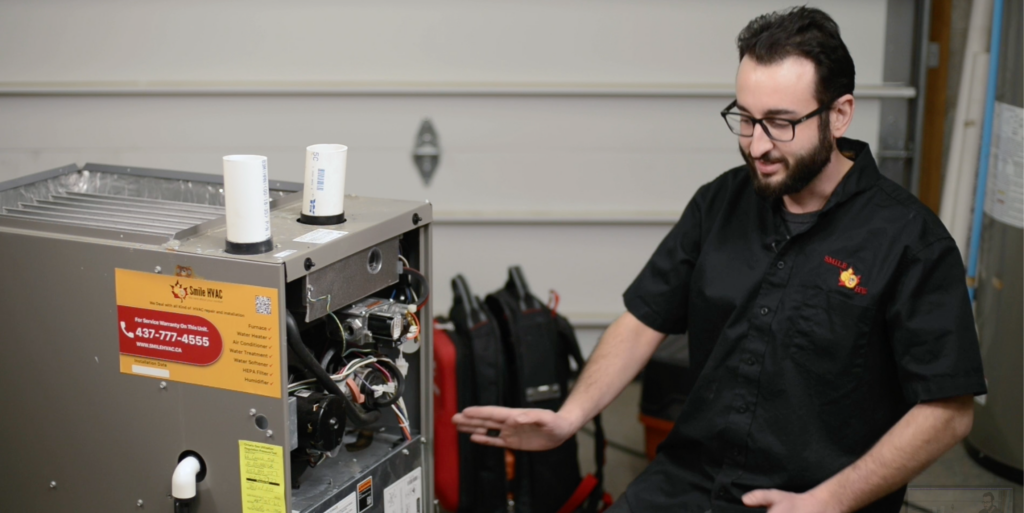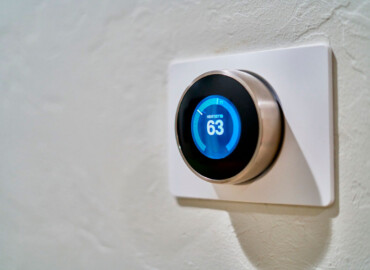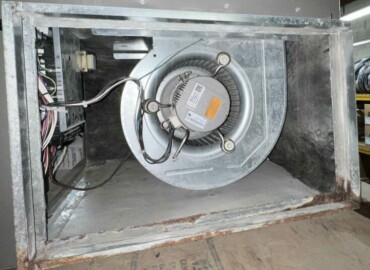Why my Furnace is not heating the house?
A well-functioning furnace makes you feel warm and comfortable, but what if it stops producing appropriate heat, especially when chilly weather is around the corner? Obviously, the furnace acting like this can be annoying and inconvenient.
Before thoroughly relying on your furnace, make sure it is able to heat your entire home. However, there can be many reasons behind the furnace not heating the home, ranging from complex to straightforward ones that most homeowners can easily resolve. If the situation surpasses your hands, call and consult a Smile HVAC expert. Whatever the problem may be, our craftsmen are available to help anytime.
But if you’re going to tackle the task yourself, make sure you’re aware of the model and construction of the furnace, after all, so you don’t have to make things worse. Before that, let’s take a look at what is the most common reason behind a furnace not being able to provide proper heat throughout your property. With this valuable insight, you can easily diagnose and fix problems to ensure your winter nights are warm and comfortable.
An overview on the furnace isn’t producing enough heat:
To help you understand things in depth, we have tried to cover a few aspects that might be responsible for not producing enough heat.
- Faulty thermostat
- Problem with Limit Switch
- Flame Sensor isn’t working
- Problem with Gas Supply (in gas furnaces)
- Airflow issues
- Leaks in vents and ductwork
- Lack of maintenance
- Owning an Inappropriate-size furnace
- Dirty air ducts
- Lack of Insulation
- Issues with Pilot Control or Ignition, etc.
9 Main Reasons Your Furnace Isn’t Heating Your House Properly
There are plenty of reasons why your home furnace isn’t spreading heat within your property. The biggest reason for this could be the size of your house. Book an appointment with Smile HVAC to find out the actual reason. Our experts are there to adequately diagnose furnace problems so you can have the right amount of heat when it’s cold outside.
1. Thermostat malfunctioning
Probably, most of you may not be aware that the thermostat rather than the furnace may be at fault with the temperature in your property. A malfunctioning thermostat may result in a failure to signal the furnace to diffuse heating or an incorrect temperature reading. Here are some possible reasons that indicate the thermostat is not working properly:
- Thermostat life span: A good quality thermostat, even a thermostat from a reputed brand, has a maximum life span of 10 to 12 years. With use and time, their performance gradually degrades. If you are having furnace heating problems, take a look at your thermostat life; otherwise, call a specialist and let them tell you if it needs to be replaced.
- Incorrect temperature: One of the obvious reasons is the furnace isn’t set to the appropriate temperature. Ensure your smart thermostat is reaching its adequate number, 20 to 22 degrees in chilly weather, for instance. In addition, make sure it is turned on to the heat option.
- Old batteries: Upgraded thermostats are typically designed to be connected to your home’s electrical system. While some homeowner still use batteries as their backup or main power source. Over time, compared to an electric thermostat, a battery-powered thermostat starts to give you headaches and discomfort, so simply replace the batteries to take advantage of continued use.
- Incorrect placement: Not getting the desired temperature is sometimes due to a misaligned thermostat rather than an internal problem. For optimum performance, your thermostat should be placed at least 150cm above the floor, away from windows, drafts and other sources of intense cold or heat.
- Wrong Wiring: Even though DIY installation can help save a lot of money, it may not always be successful. However, unless you are an expert in working with wiring connections, thermostat wiring is a major task that should be done by experts. DIY-related problems and loose connections, in general, can damage your equipment, putting your home wiring at risk.
2. Air ducts full of debris and dust
This is another common reason why your furnace may be having difficulty providing heat. Note that we’re not talking about the furnace that has stopped working somehow.
Most of the time, homeowners are negligent in cleaning around and inside the furnace air ducts. Accumulations of dust, dirt, grime, and hair from both pets and people in the home can impede airflow as well as make it harder for warm air to enter each room.
To prevent poor performance of a furnace, especially when it is not heating a home properly, make sure the air filter is in good condition, and most importantly, clean if it is old. Air ducts should be cleaned every 3 to 4 years. With proper cleaning, hopefully, air will circulate around your property, and rooms will be heated more evenly. Replace your air filter if necessary to support smooth airflow.
However, filter replacement is a simple and quick task and beneficial in the long run in safeguarding HVAC parts and improving air quality within the property.
Things to do:
- Find your filter – Furnaces may have their filters either within the intake, resembling a grate in the ceiling, floor, or wall, or inside the furnace unit itself.
- Inspect your filter – To make sure whether or not the filter requires replacement, hold it up to the light. If doing so will not show any light ignite through it, it’s high time to change the filters. Another scenario when you need to replace your furnace filter is a musty, dusty smell coming from the vents when the blower is running.
- Change your existing filter – While replacing your filter with a new one, inspect if the furnace is turned off, which means no air is coming out. Note the filter’s directional markings. Furnace filters are thoughtfully designed to collect particles blown from one particular direction. Having said that, avoid placing your filter upside down, eliminating its efficiency in sucking airborne particles.
More efficient, usually newer furnaces are prone to the issue and will probably stop working before a dusty filter causes more nuisances. Some furnace units may continue to operate but with lower efficiency and less heat output.
3. Owning an Inappropriate-size furnace
Buying a new home only provides a rough idea until you fully understand the place. There may be a possibility that previous homeowners didn’t install the components thoroughly. Or maybe they preferred the economical option over the better one.
This is to say that choosing a furnace that does not suit the size of your home can lead to many problems. For example: If you have a small furnace, it will not be able to give enough heat, which will make you feel uncomfortable and cold. If the furnace is large in size, on the other hand, it will quickly heat up the property and then shut off, resulting in repeated on-off cycles. This will eventually increase your utility bill.
To determine how much electricity your furnace needs to heat your property, measure your unit’s British Thermal Unit. BTU measures the actual amount of heat produced by your unit. The larger the size of the house, the more electricity is needed to generate heat. Apart from the size of the property, you have to consider the climate and the place where you live. This means people living in colder climates are advisable to opt for a furnace with a higher BTU output/per square foot.
4. Lack of maintenance and cleaning
Typically, a premium-quality furnace last for 12 to 15 years. Negligence in maintenance and cleaning can cause a number of problems with a furnace, such as increased wear and tear and reduced heating efficiency. But, with regular maintenance, you’ll be exposed to furnace problems beforehand.
Plus, getting seasonal service appointments with Smile HVAC keeps your air ducts clean, increasing efficiency and making them last for years. Understand that as time goes on, your home furnace will lose its ability to provide warm air within the property by becoming less efficient. The more a furnace is used over the years, the more frequent repairs it will see, including worn blower motors, cracked heat exchangers, and more.
5. Lack of Insulation
Inappropriate or less insulation is another major issue, especially if your property hasn’t switched to an adequate heating system. Home insulation can be less efficient over time. The ability to absorb moisture varies depending on your home’s insulation.
To retain heat effectively, keeping the insulation around air ducts dry is important. If you see modern insulation, they are much more capable of preventing heat from escaping via small holes and cracks. Make sure the property is insulated well so that your furnace will work more efficiently.
6. Problem with the limit switch
To minimize and maximize the heating power of the furnace, each furnace is provided with a safety feature. If the furnace starts to overheat, immediately turn off the limit switch. However, a problem with the limit switch can cause the furnace to shut down prematurely, resulting in insufficient heating. To solve that problem, the best solution is to replace the limit switch.
7. An issue with Gas Supply in a Gas furnace
A proper and steady gas flow is important for efficient and constant heating in gas furnaces. Having issues with gas supply is due to gas line blockages, malfunctioning gas valves, or issues with the gas meter. So, be aware of these issues to prevent interruption in heating.
8. Issues with Pilot Control or Electric Ignition
A gas furnace works using a pilot light, and even some have power control that reduces the requirement for a stable flame. A malfunctioning pilot control can gradually decrease the ability of the furnace to warm the property adequately. An obstruction or draft in your HVAC system may result in your electric ignition or pilot light going off.
What to do:
In such a case, you will need to follow the few steps below to improve the heating ability of the furnace:
- Toggle on and off the furnace power switch. Simply, you need to reset the ignition.
- Shut down gas and electricity in the unit so that the heating unit can be inspected easily. Stay away from touching the heating unit. You may need to replace the igniter if it appears damaged or cracked.
- For a safe and friendly troubleshooting process, you are advised to follow the user manual steps recommended by the brand or manufacturer.
Call for an HVAC expert if the above-mentioned doesn’t work.
9. Leaks in ductwork and vents
Leakage found in vents and ductwork may cause trouble by gradually losing heated air before it enters the property. Due to this, you have to settle for low efficiency along with paying a higher electricity bill. Learn how to find and seal vent leaks to ensure that warm air is circulating throughout your living space.
To sum up!
Instead of buying a new furnace which can put a burden on your pocket, you should try to solve the problem of the furnace not producing heat in the house. Most of the above tips will help you save money by extending the life of your furnace and keeping you and your family feeling warmer. That’s it for this post! Thank you.




